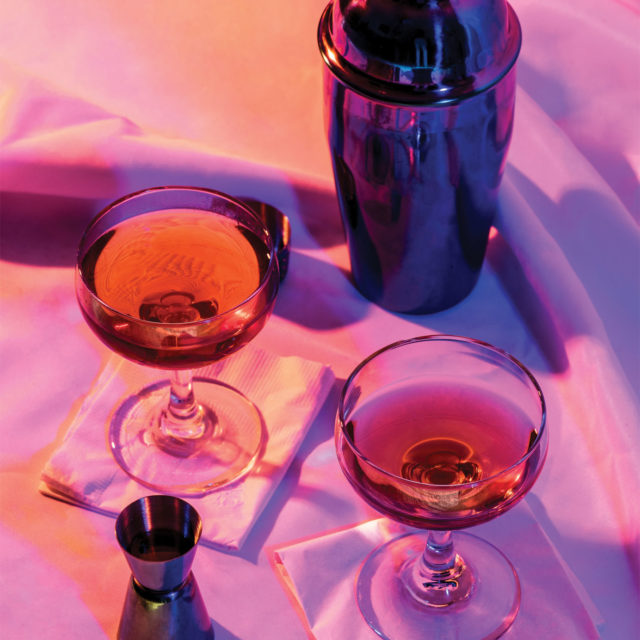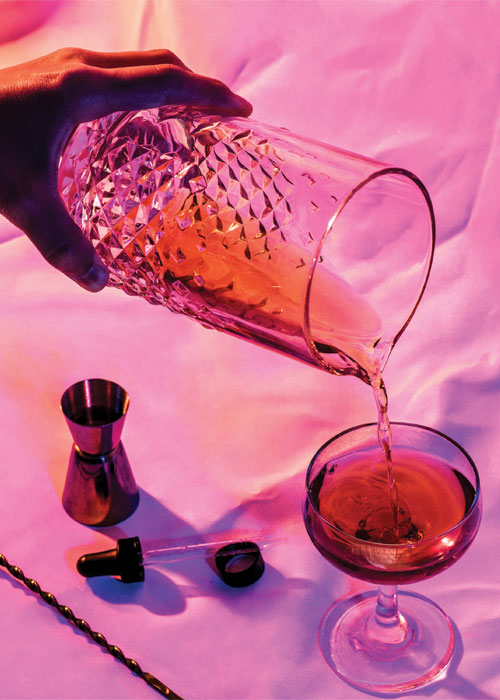In a 2009 article for queer publication Between the Lines, writer Camper English laments the lack of “couture cocktails” at gay establishments, pointing to the stereotype that “we’re supposed to be trendy people.” Having covered cocktail culture since 2006, English believes drinks programs at gay bars have remained remarkably static as the bar and restaurant industry have drastically evolved.
Ten years later, he says that’s still the case. “It dawned on me that none of the gay bars were moving in the same direction as other bars — they were just doing the same old flavored vodka drinks, most without fresh juices or even drink menus,” English tells VinePair. “These days, there are some gay bars using fresh juices in their cocktails, at least, and more of the restaurants in gayborhoods are getting it right. But it seems generally that gay bar cocktails are about where nightclub cocktails are in terms of average quality.”
Of course, the high-volume drinks programs at some gay venues function primarily as social lubricants. They are designed to lower inhibitions, complementing the shirtless go-go dancers, pounding music, and condom dispensers. Why, though, can’t excellent cocktails and handy condoms coexist?
While the mixology movement has brought well-made Manhattans and Mojitos to hotel bars, cruise ship bars, piano bars, music festival bars, and, hell, even airplane bars, 20 years after the cocktail revolution launched in NYC, gay bars are one of the last places in America you can’t always find a good drink. With so many priorities to juggle, from shifting socioeconomics to vanishing venues, gay bars and cocktail culture are now at a historic crossroads.
“We think of cocktail bars as a place to go and have a curated experience,” says Alex Negranza, a gay bartender and director of operations at Tongue-Cut Sparrow and The Pastry War in Houston. “Historically, we don’t have that association in the gay bar scene because, for so long, gays were never afforded the luxury of a place to indulge. … They needed places to be safe, and be away from society.”
Much has changed, and continues to change, since bars like San Francisco’s Black Cat and New York’s Stonewall opened in underserved neighborhoods to provide refuge to gay communities in the 1950s. Namely, the steady closing of the “gay wage gap.” According to the latest studies from Prudential and the Harvard Business Review, the average queer American — albeit mostly cis white gay males — now earns as much if not more than their straight counterparts.
Then there’s the fact that today’s “gayborhoods,” like Chelsea in New York, Boystown in Chicago, or Montrose in Houston, are among their cities’ whitest and most affluent. Modern gay bars, likewise, no longer inhabit the same cultural and physical spaces as their predecessors. Widespread acceptance of LGBT culture in large cities, while offering safety and visibility for the community, has stripped these establishments of their edge. And, one could argue, their heart.
Some queer bartenders are hesitant to bring the craft cocktail movement, with its hand-cut ice and elevated price tags, into gay and lesbian bars because there are so few of them left. “The gay bar isn’t nearly as ubiquitous as we’d all like it to be, so switching the beverage program at even a couple of gay bars in the city makes access to queer spaces even more limited,” says Yi Chen, bartender at The Aviary NYC. “If gay bars are truly to remain about community, the message sent by cocktail-specific gay bars is one of alienation to those who can’t afford it, which implies a culture that I personally find problematic.”
Others believe queer establishments with quality cocktails would provide a welcome alternative to hard-partying gay nightlife. “I don’t really go to gay bars anymore,” Negranza says. “I just remember looking around and seeing people hooking up in the bathrooms or doing drugs on the dance floor. That’s totally fine and I think people should enjoy what they like, but it’s not for me. I like to have a nice cocktail or spirit.”
In recent years, a small handful of bars have aimed to strike a balance by serving good cocktails as well as their community. In 2016, Garrett McKechnie opened Mattachine Society, a gay cocktail bar in Los Angeles, but it sadly closed shortly thereafter. Fortunately, in early 2019, chef Angela Dimayuga, formerly of Mission Chinese Food, opened No Bar, a “new-wave gay bar” in New York City’s Standard East Village Hotel.
Dimayuga, who is lesbian and Filipina-American, says the higher-end bar suits the luxury hotel and its neighborhood, which is also home to some of the nation’s most acclaimed cocktail bars, like Death & Co. and PDT. While No Bar’s prices are competitive with those at surrounding establishments, inclusivity is important to Dimayuga. The bar is designed to serve the neighborhood’s ethnically diverse, queer-friendly crowd.
“When we introduced more affordable cocktails, we found our guests gravitated to the more high-end cocktails,” Dimayuga says. “The menu is very much a response to the neighborhood — high-end drinks and bar food in a space that is open and available to anyone. Our programming is created for the community it’s serving. There’s an extremely diverse set of people that feel at home at No Bar and we want to create nightly events that feel accessible to all.”
Events at No Bar also highlight the creative contributions of queer folks in New York, and include a monthly installment by Humberto Leon of Opening Ceremony.
When Shawn Vergara and his sister Tiffny Vergara Chung revamped their Brewcade bar in San Francisco’s historic gay neighborhood, The Castro, earlier this year, they wanted it to represent its location. Now called Detour, after a historic gay club, it serves elevated cocktails in an intergenerationally inclusive space.
“I’ve been drinking, partying, and working in the neighborhood for 15 to 20 years, but as I got older, I couldn’t find places where I could have a drink that was delicious, and that matched the place I was in my life,” Vergara says. “My palate had matured. And the mature crowd wants something a little more sophisticated. There was definitely something missing, and I wanted to show that gays can participate in cocktail culture, too.”
Caitlin Laman, founder of the cocktail conference Chicago Style, believes we could soon see many more gay-friendly or -focused cocktail bars like those McKechnie, Dimayuga, and Vergara have opened, but says those interested in courting the community need to do so thoughtfully. “The most important thing is that the people opening these bars be queer, and really care in order to create a space that’s opening and safe for the queer community — it’s going to take creative thinking on the business side and marketing side,” Laman says.
Beyond putting up rainbow stickers, some cocktail bars now do more to seek out the queer community when hiring — Facebook posts will make note of preference to qualified POC and LGBT applicants, for example. Others offer programming for LGBT patrons, such as Brooklyn’s Donna Cocktail Club, which hosts a queer happy hour every other Sunday, and Oakland’s Starline Social Club, which puts on a monthly queer dance party.
In July 2019, Christina Cabrera, 41, moderated a panel at Tales of the Cocktail called “Turning Allies Into Advocates.” It featured Negranza along with New York bar pioneer Julie Reiner and Whit Kathner of Washington, D.C.’s women-owned Republic Restoratives distillery.
“My seminar at Tales was the first of its kind. It took 15 years to have a queer-focused seminar,” Cabrera says. “I think the industry wants to be better, there are people out there who genuinely want to be more inclusive. I heard from straight people afterwards who said they were unaware of the struggle, and that they want to do things like be more conscious of pronouns.”
Cabrera, who uses the pronouns they/them, serves as the New York ambassador for Grey Goose. They say spirits brands have enormous potential to diversify the offerings in and impressions of queer cocktail bars. A lot of programming depends on what brands bars work with or have in stock. Cabrera point to brands like Stoli and Absolut, which have invested in the queer community for decades, along with some of Bacardi’s recent efforts during Word Pride NYC 2019.
“Our community is one to invest in — if all I can do is start the conversation, then I’ve done my part,” Cabrera says.
The success of establishments like No Bar and Detour shows that a delicate middle ground for gay cocktail bars can and should exist — as long as queer people are empowered to open them. “As a generation, we need to leave things better than how they were when we walked in,” Cabrera says. “Your dollars are your vote, so know what products you’re putting behind the bar. We appreciate you coming to the parade with us, but we need you to fight with us and fight for us.”
This story is a part of VP Pro, our free platform and newsletter for drinks industry professionals, covering wine, beer, liquor, and beyond. Sign up for VP Pro now!

